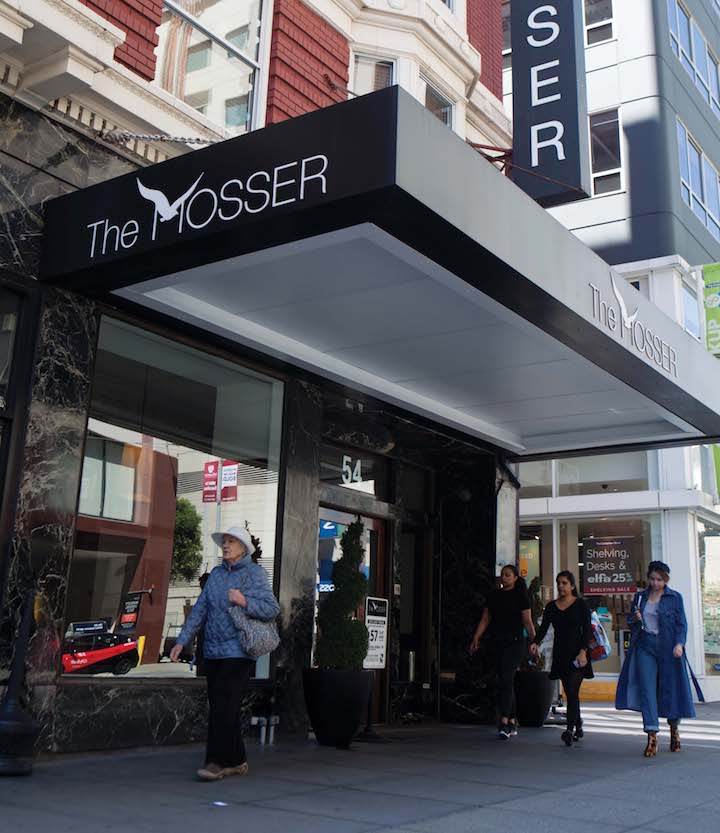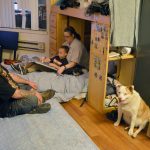Last week on his blog, Beyond Chron, Tenderloin Housing Clinic Executive Director Randy Shaw belatedly referred to my fall 2017 Public Press cover story about vacancies in single-room occupancy hotels as “extremely misleading” and “false.”
I was disappointed, but not surprised. And I am not alone. I have spoken with a number of people in the same line of work as Shaw: protecting and/or housing impoverished SRO residents. They are bewildered at his claim that he “cannot think of a single SRO owner who thinks that a good profit strategy is keeping units off the market.”
They can. They can provide documentation, as can the city.
And, what’s more, they don’t comprehend how Shaw cannot. “I have been in meetings to talk about this situation,” one told me. “Meetings Randy convened.”
‘Five Sisters’ Conversion Project
Some of these meetings involved the so-called Five Sisters project, a complex proposal in which a series of residential hotels largely housing the indigent would be converted into tourist hotels, and, in exchange, new residential units would be constructed. But there was a catch: Many of the residential units were conspicuously vacant.
The reason for this, quite plainly, is that it was a good strategy to keep units off the market.
If an occupied residential room is converted into a tourist room, the occupant must, by city law, be offered a new residential room at his or her prior rent — often jarringly below market rate. But if that room is empty, it’s a neat double-dip for the hotel owner. He gets to enter the lucrative tourist hotel business and also gets to rent out to a new person at a sky-high market rate to boot.
That’s likely why, as we noted in our story, The Mosser, 54 4th St., reported that 68 of its 81 residential units were not occupied. The current plans for that hotel, reported recently, are to convert those 68 rooms to serve tourists. And not just any tourists: Rates will purportedly reach $599 a night.
High-Vacancy ‘Red Flag’ Hotels
There are activists and organizers, in fact, who track SRO vacancy rates and denote “red flag” hotels, where the high percentage of unoccupied rooms denote a good likelihood of conversion — legal or otherwise — to a tourist hotel. SRO properties for sale explicitly note the number of vacant rooms, as — intuitively — the building gains value when it has fewer longtime tenants paying 1979 rents and more opportunities to charge new tenants 2018 rents.
In fact, while she prepared razor clams in the kitchen of her SRO at 790 Vallejo St. we visited for the story, elderly Mrs. Zeng calmly explained to me through a Cantonese translator that this was exactly what happened in her building. Same story from the folks at the Chinatown Community Development Center who work with tenants in this and every Chinatown SRO.
Shaw offers “facts” about several of the specific hotels mentioned in our story. But these “facts” often only reinforce what we reported in our story. He points out that the Minna Lee Hotel, 149 6th St., is undergoing a long renovation after a fire. But we noted in our article that fire damage and lengthy renovations are often the culprit for largely empty hotels. He notes that 706 Polk St. is “primarily a tourist hotel.” But it’s zoned residential and was a residential hotel for years. Perhaps Shaw, who operates nearby facilities, is fine with respectful tourists renting the place out now. But it still represents a loss of scores of affordable units for the city.
Shaw denigrates our use of the Department of Building Inspection’s annual unit-usage numbers, which revealed 1,827 vacant rooms — not including the 60 hotels that blew off reporting requirements. Like the biennial homelessness point-in-time count (though far more accurate), this is a measure of a hotel’s occupancy on a chosen day; it is not monitored in real time.
It’s also true that there’s a goodly degree of turnover in SROs. But these stats reveal at least 30 hotels that are 50 percent or more vacant, and scores with significant vacancies. That’s harder to write off. Also, while Shaw has impressive expertise, decades of institutional memory and a keen intellect, he’s not revealing any numbers at all that back up his contentions — and no journalistic reportage whatsoever.
Saga of the Bristol Hotel
As such, Shaw bemoans our reporting that the Bristol Hotel, at 56 Mason St. is, per the city, 100 percent vacant. He counters that this hotel’s owner offered to lease the place to the city for homeless housing — to be run by Shaw’s outfit — but the city rejected the plan as too costly.
And yet that hardly belies the point of our article. It only strengthens it. SROs are long past being only coveted by altruistic nonprofits hoping to house the homeless. They are valuable real estate, which creates market pressures to drive up that value. And the owner of this hotel did just that; he long ago hatched plans to maximize value that didn’t include Shaw administering to the indigent.
Court papers reveal that, in 2013, Balwantsinh Thakor, the owner of the Bristol Hotel, which was highlighted in our report, advertised the place to would-be moneylenders as aiming to become “mixed use with student housing and tourist guests staying.”
In August of that year, per the court, a “conversion plan” was prepared which falsely claimed that “agreements were made with existing tenants … for them to move out permanently and convert the building into a fully tourist licensed hotel.” And that would have suited the lenders fine: They later testified that “they had entered into a commercial loan discussions with Mr. Thakor upon the understanding the Hotel was vacant and that no rent-controlled tenants would be returning. Tourist units would have had a much higher steam of income than was projected by the banks.” (Emphasis added.)
These quotes were excerpted from a judgment in favor of former Bristol tenants the court found had been improperly ejected and whom the court demanded Thakor rehouse.
And while the city balked at plans to house homeless people in this hotel, something along the lines of Thakor’s long-gestating and lucrative plan has indeed come to pass.
SRO Becomes White-Collar Dorm
On Monday, readers of the New York Times saw the apparent end result of keeping those rooms empty: Housing for the middle class or affluent provided by Starcity, which specializes in converting SROs into dormitories. While one building is referred to only as “Mason Street,” an exterior photo of the future 71-unit residence for white-collar workers clearly depicts 56 Mason St. — the Bristol Hotel. There’s a telltale mural and, unsubtly, the number “56” adorning the plywood doorframe.
The Times story does not mention how the Central City SRO Collaborative used to organize the poor tenants of these dorms-to-be. It does not mention how AIDS patients used to be placed in this building. It does not mention the lawsuit by Thakor’s ejected tenants. It barely hints at displacement.
Far from being “false” or “misleading,” our story pointed out profit-seeking private actors are the competitors for the city in obtaining the scant SRO housing left on the market — with far different goals for the property.
Shaw has done much great and valuable work in this city. The disenfranchised need him more than ever. We’re as confident he will rise to this task as we are baffled by his mischaracterization of our article.










